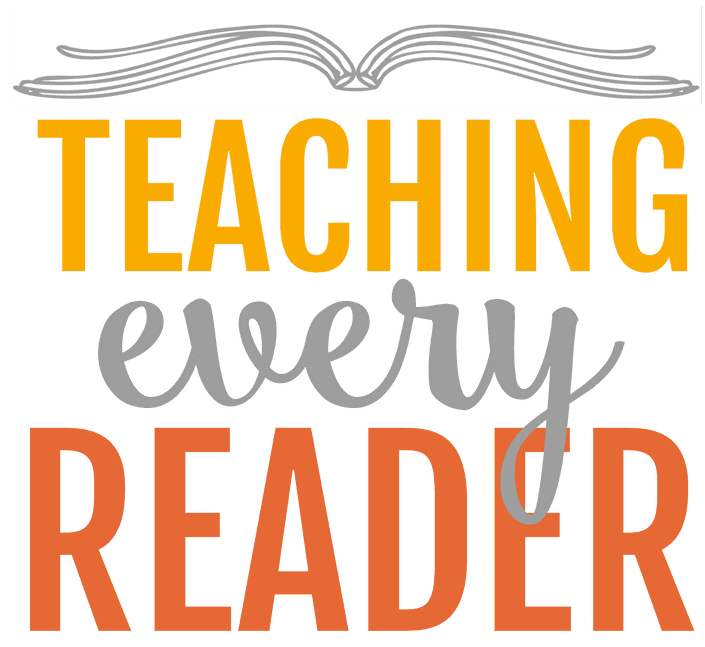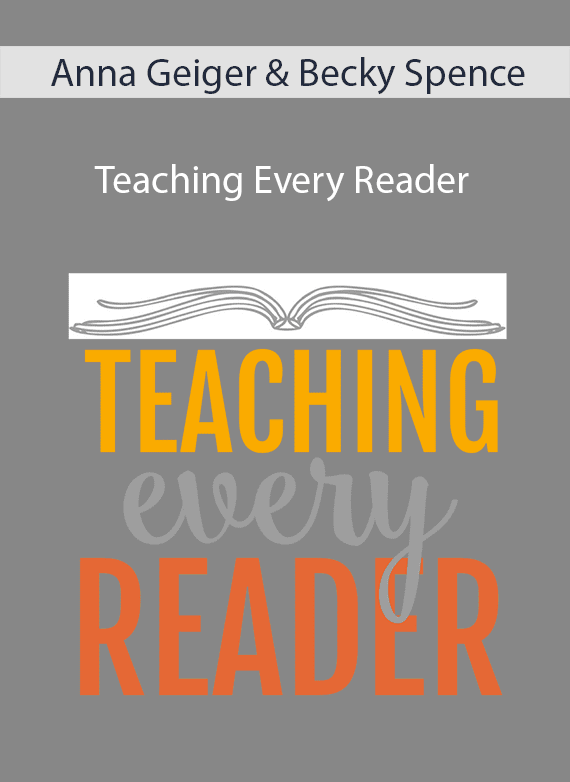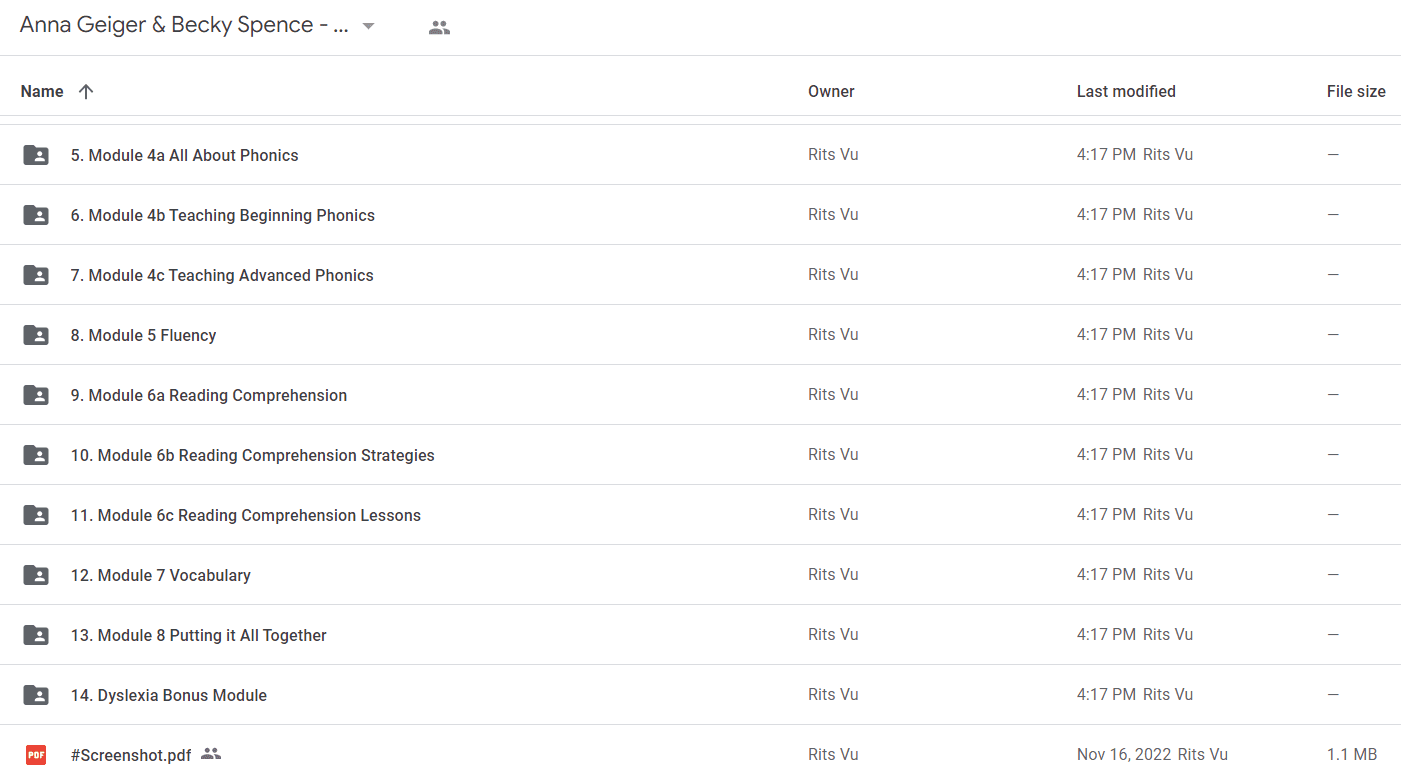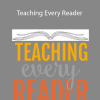Anna Geiger & Becky Spence – Teaching Every Reader
$309.00 Original price was: $309.00.$76.00Current price is: $76.00.
Instant Download: You will receive a download link via your order email immediately
Should you have any questions, please contact us: [email protected]
 Anna Geiger & Becky Spence – Teaching Every Reader
Anna Geiger & Becky Spence – Teaching Every Reader
Confidently teach every reader in your classroom. Still have time to live your life.
Course Curriculum
Welcome!
- Welcome to Teaching Every Reader 2.0! (Start here)
- Course schedule
- How to access the lessons (2:14 )
- About the Facebook Group
- How to contact us
- How to get your completion certificate for Teaching Every Reader 2.0
- Want to get all the modules unlocked at once? Here’s how!
- DOWNLOAD YOUR BONUS FILES BY OCTOBER 31, 2022
Module 1: The Big Picture
- Lesson 1: A look back … The reading wars in America (10:39 )
- Lesson 2: How we identify and remember words (6:11 )
- Lesson 3: How the brain learns to read (3:57 )
- Lesson 4: The phases of sight word development (4:57 )
- Lesson 5: The simple view of reading (4:03 )
- Lesson 6: Scarborough’s Reading Rope (4:16 )
- Lesson 7: The 5 key components of reading instruction (2:27 )
- Lesson 8: Balanced vs. Structured Literacy (7:36 )
- Lesson 9: Three Cueing vs. The Four Part Processor (5:32 )
- Lesson 10: Putting it all together (3:53 )
- QUIZ
Module 2: Oral Language
- Introduction
- Lesson 1 – Why is oral language important? (3:42 )
- Lesson 2- The components of oral language (2:41 )
- Lesson 3 – Use academic language (2:18 )
- Lesson 4 – Use explicit instruction to teach listening and speaking skills (5:01 )
- Lesson 5 – Increase opportunities for student talk (4:08 )
- Lesson 6 – Ask open-ended questions (1:31 )
- Student Printables: Oral Language
- QUIZ
Module 3: Phonological & Phonemic Awareness
- Lesson 1 – What are phonological and phonemic awareness? (7:58 )
- Lesson 2 – Rhyming (5:06 )
- Lesson 3 – Alliteration (5:01 )
- Lesson 4 – Word awareness (3:43 )
- Lesson 5 – Syllables (8:35 )
- Lesson 6 – Onsets and Rimes (3:13 )
- Lesson 7 – Understanding phonemes (12:26 )
- Lesson 8 – Phonemic awareness (7:22 )
- Lesson 9 – Assessing phonological & phonemic awareness
- Student Printables: Rhyming Activities
- Student Printables: Syllables
- Student Printables: Phoneme Isolation Activities
- Student Printables: Phoneme Blending Activities
- Student Printables: Phoneme Segmentation Activities
- Student Printables: Phoneme Manipulation Activities
- Extra Printable Activities
- QUIZ
Module 4a: All About Phonics
- Lesson 1: Phonics Basics (7:48 )
- Lesson 2: Is the English language illogical? (1:47 )
- Lesson 3 – The Alphabetic Principle (8:02 )
- Lesson 4 – 8 Characteristics of effective phonics instruction (3:32 )
- Lesson 5 – Using decodable texts (10:45 )
- Lesson 6 – A recommended sequence for teaching phonics skills
- Lesson 7 – Assessing phonics knowledge
- QUIZ
Module 4b: Teaching Beginning Phonics
- Lesson 1: Letter Recognition
- Lesson 2: Letter Sounds
- Lesson 3: Blending (9:22 )
- Lesson 4: Teaching Spelling through Dictation (6:13 )
- Lesson 5: Word Building, Word Sorts & Word Ladders (7:58 )
- Lesson 6: Structure of an Effective Phonics Lesson
- Student Printable Activities: Letters & Sounds (letters, digraphs, blends, clusters)
- Student Printable Activities: Short Vowel & Bossy r Words (CCV, CCVC, CVCC)
- Student Printable Activities: Long Vowels & Other Vowels (CVCe, CVVC, diphthongs)
- More Phonics Printables
- QUIZ
Module 4c: Teaching Advanced Phonics
- Lesson 1: Teaching Students to Read Multisyllable Words (2:43 )
- Lesson 2: The 6 Syllable Types
- Lesson 3: Syllable Division (14:01 )
- Lesson 4: Prefixes & Suffixes (4:33 )
- Student Printable Activities: Compound Words & Six Syllable Types
- QUIZ
Module 5: Fluency
- Lesson 1: What is Fluency? (4:14 )
- Lesson 2: Assessing Fluency (4:53 )
- Lesson 3: Modeling Fluency (1:19 )
- Lesson 4: Echo & Choral Reading
- Lesson 5: Partner Reading
- Lesson 6: Reader’s Theater & Partner Plays
- Lesson 7: Timed Repeated Reading
- Lesson 8: FORI (4:37 )
- Lesson 9: The Fluency Development Lesson
- Lesson 10: Teaching High Frequency Words
- Lesson 11: More about Teaching High Frequency Words (12:20 )
- Lesson 12: Make a Plan
- Student high frequency word and fluency activities
- QUIZ
Module 6a: Reading Comprehension
- Lesson 1: What is Reading Comprehension? (4:23 )
- Lesson 2: A Summary of the Research (7:04 )
- Lesson 3: Interactive Read Alouds
- Lesson 4: Syntax and Sentence Comprehension (14:25 )
- Lesson 5: Story Structure (16:45 )
- Lesson 6: Text Structure in Informational Texts (4:34 )
- Lesson 7: Nonfiction Text Features (4:45 )
- Lesson 8: Cohesive Ties (7:52 )
- Lesson 9: Main Idea (11:33 )
- Lesson 10: Assessing Comprehension
- Printable student activities for comprehending fiction
- Printable student activities for comprehending nonfiction
- QUIZ
Module 6b: Reading Comprehension Strategies
- Lesson 1: What Does the Research Say? (2:47 )
- Lesson 2: How to Teach Reading Comprehension Strategies
- Lesson 3: Activating Prior Knowledge
- Lesson 4: Making Connections
- Lesson 5: Predicting
- Lessong 6: Inferring
- Lesson 7: Visualizing
- Lesson 8: Asking Questions
- Lesson 9: Retelling and Summarizing
- Lesson 10: Monitoring comprehension
- QUIZ
Module 6c: Reading Comprehension Lessons
- Lesson 1: A Lesson Framework (2:21 )
- Lesson 2: Before reading
- Lesson 3: During reading
- Lesson 4: After reading
- QUIZ
Module 7: Vocabulary
- Lesson 1: What Does the Research Say About Teaching Vocabulary? (2:51 )
- Lesson 2: What Words Should We Teach?
- Lesson 3: Teaching Vocabulary Through Read Alouds
- Lesson 4: Teaching Vocabulary Before Reading and During Reading (4:23 )
- Lesson 5: Teaching New Words in Depth (7:54 )
- Lesson 6: Word-Learning Strategies
- Lesson 7: Word Consciousness
- Student Printables: Vocabulary
- QUIZ
Module 8: Putting it All Together
- Introduction (0:59 )
- Lesson 1: Determining Your Schedule (4:21 )
- Lesson 2: Setting Up Your Classroom
- Lesson 3: Teaching Tips for Whole Group Interactive Read Alouds
- Lesson 4: Guided Reading vs. Skills-Based Groups (9:49 )
- Lesson 5: How to Implement Small Group Phonics Lessons (8:05 )
- Lesson 6: What if You HAVE to do Guided Reading?
- Lesson 7: Independent Reading (10:06 )
- Lesson 8: Ideas for Fluency Building
- Lesson 9: Getting Started with Literacy Centers
- Lesson 10: Top Tips for Effective Literacy Centers
- Lesson 11: Managing Literacy Centers (3:21 )
- Lesson 12: Teaching Independence at Literacy Centers (10:02 )
- Lesson 13: Ideas for engaging, low-prep literacy centers you can use all year long
Dyslexia Bonus Module
- Lesson 1: FAQ About Dyslexia (0:43 )
- Lesson 2: What is Dyslexia? (4:24 )
- Lesson 3: The Signs of Dyslexia (7:36 )
- Lesson 4: Getting Tested for Dyslexia (7:48 )
- Lesson 5: Getting Help for Dyslexia (6:41 )
- Lesson 6: Explicit Teaching (5:30 )
- Lesson 7: Systematic Teaching (5:22 )
- Lesson 8: Repetition and Review through Guided Practice (7:33 )
- Lesson 9: Engagement (3:44 )
Proof Content
Sale Page: https://geigerandspence.com/p/teaching-every-reader
Archive: https://archive.ph/wip/GUvFc





Reviews
There are no reviews yet.